Cache Memories
CSC 235 - Computer Organization
References
- Slides adapted from CMU
Outline
- Cache memory organization and operation
- Performance impact of caches
- The memory mountain
- Rearranging loops to improve spatial locality
- Using blocking to improve temporal locality
Recall: Locality
Principle of Locality: Programs tend to use data and instructions with addresses near or equal to those they have used recently
- Temporal locality:
- Recently referenced items are likely to be referenced again in the near future
- Spatial locality:
- Items with nearby addresses tend to be referenced close together in time
Recall: Memory Hierarchy
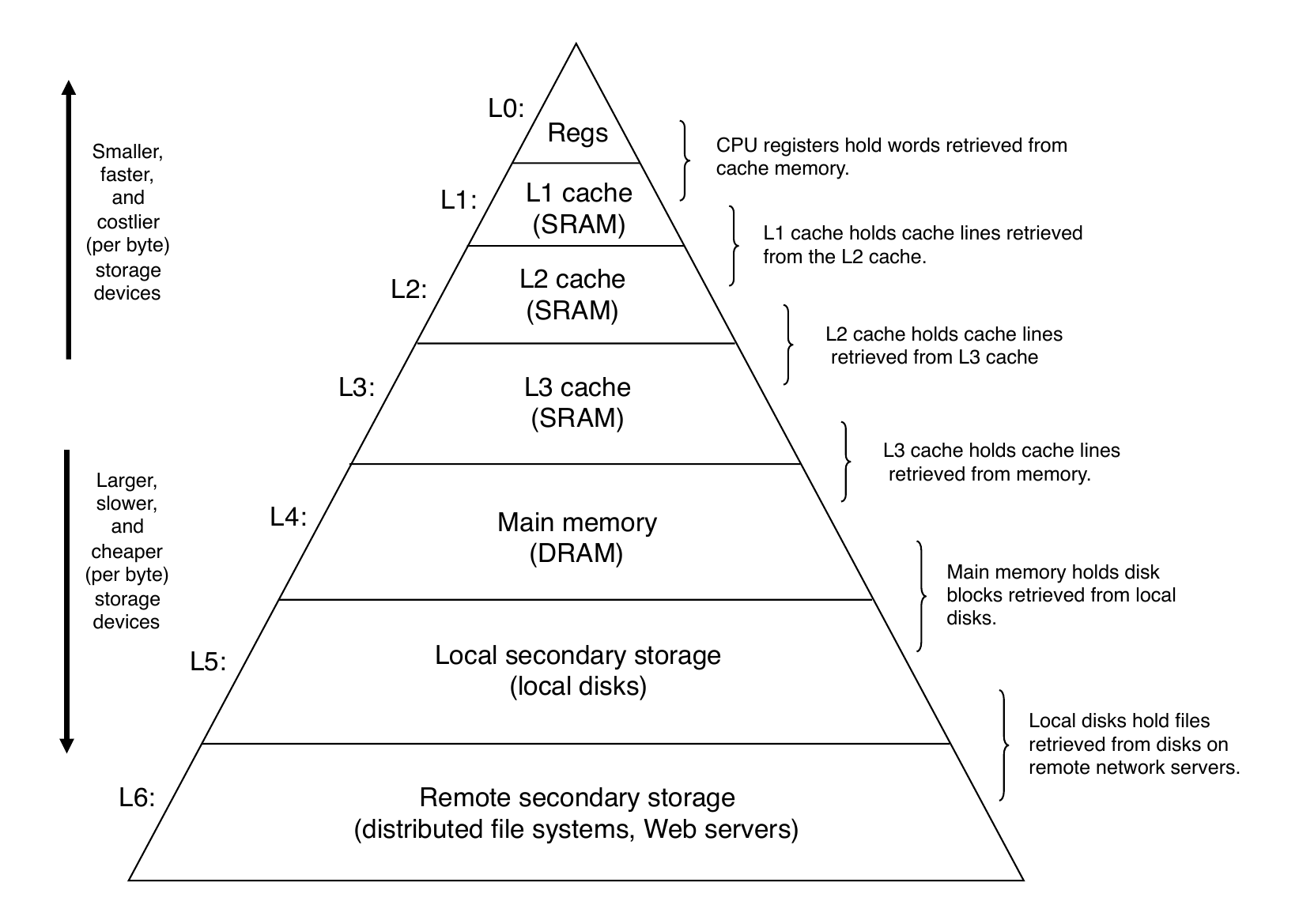
Recall: General Cache Concepts

Recall: General Cache Concepts
A cache hit is when the data in block \(b\) is needed and is in the cache
A cache miss is when the data in block \(b\) is needed and is in not the cache
- Types of cache misses:
- Cold (compulsory) miss: occur because the cache starts empty and this is the first reference to the block
- Capacity miss: occur when the set of active cache blocks (working set) is larger than the cache
- Conflict miss: occur when the level \(k\) cache is large enough, but multiple data objects all map to the same level \(k\) block where a block is a small subset of the block positions at level \(k-1\)
Cache Memories
- Cache memories are small, fast SRAM-based memories managed automatically in hardware
- Hold frequently accessed blocks of main memory
CPU looks first for data in cache
Typical system structure:
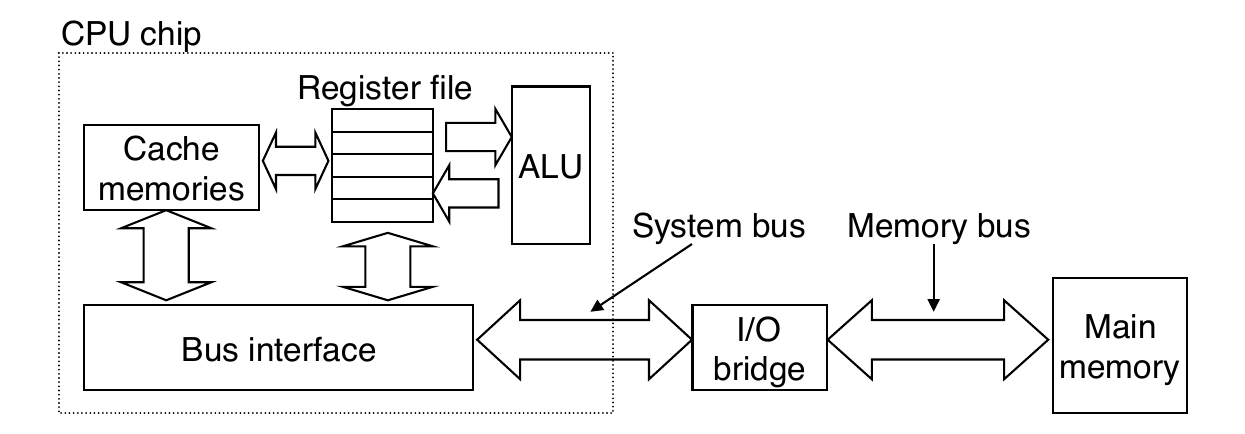
General Cache Organization (S, E, B)

Cache Read
Locate set
Check if any line in set has matching tag
Yes and the line is valid: hit
Locate data starting at offset
Example: Direct-Mapped Cache
- Direct mapped: one line per set (E = 1)

Example: Direct-Mapped Cache

- Note: the middle bits are used for indexing due to better locality
Example: Direct-Mapped Cache
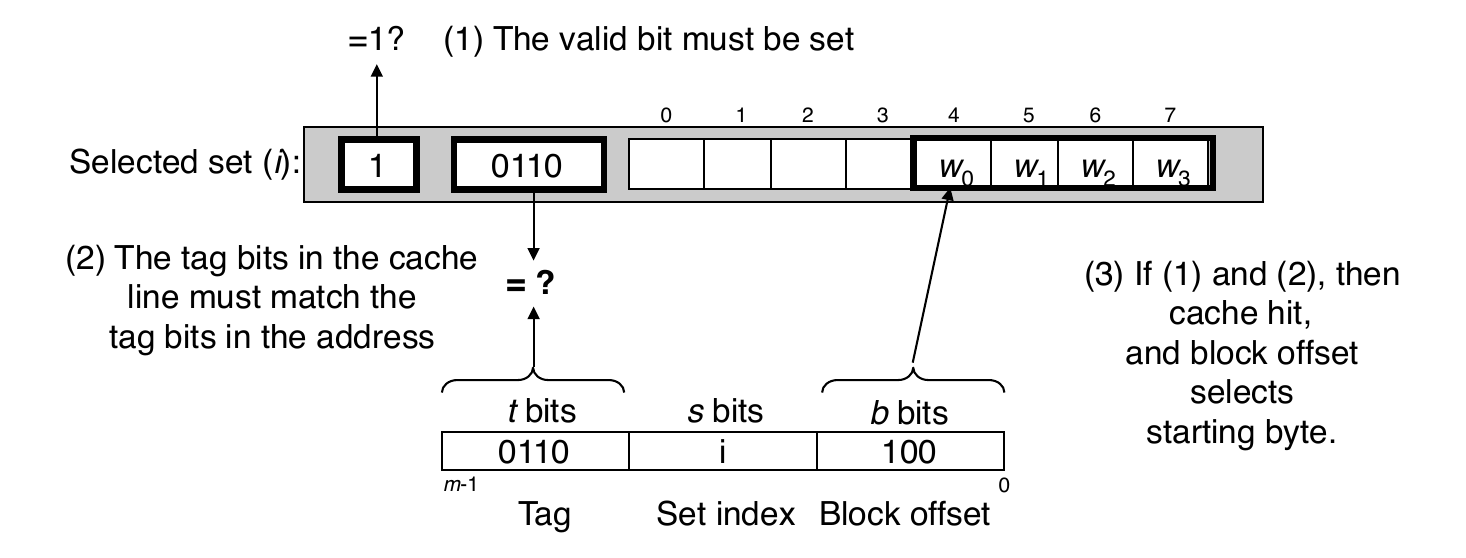
- Note: if tag does not match, then old line is evicted and replaced
Direct-Mapped Cache Simulation
Parameters: 4-bit addresses (address space size M = 16 bytes), S = 4 sets, E = 1 Block per set, B = 2 bytes per block
Address trace (reads, one byte per read)
Address t s b Type 0 0 00 0 miss (cold) 1 0 00 1 hit 7 0 11 1 miss (cold) 8 1 00 0 miss (cold) 0 0 00 0 miss (conflict) Cache after trace
Set Valid Tag Block 0 1 0 M[0-1] 1 0 2 0 3 1 0 M[6-7]
Example: E-way Set Associative Cache
There are E lines per set
- Procedure
- Find the set with the s-bits
- Compare the tag for all E lines to the t-bits
- If any of the tags match, then there is a hit
- Otherwise, select a line for eviction and replacement from within the set
There are many ways to select a replacement: random, least recently used (LRU), etc.
2-way Set Associative Cache Simulation
Parameters: 4-bit addresses (address space size M = 16 bytes), S = 2 sets, E = 2 blocks per set, B = 2 bytes per block
Address trace (reads, one byte per read)
Address t s b Type 0 00 0 0 miss 1 00 0 1 hit 7 01 1 1 miss 8 10 0 0 miss 0 0i 0 0 hit Cache after trace
Set Line Valid Tag Block 0 1 1 00 M[0-1] 0 2 1 10 M[8-9] 1 1 1 01 M[6-7] 1 2 0
Cache Writes
- Multiple copies of data exist:
- L1, L2, L3, Main Memory, Disk
- What to do on a write-hit?
- Write-through (write immediately to memory)
- Write-back (defer write to memory until replacement of line)
- Each cache line needs a dirty bit (set if data differs from memory)
- What to do on a write-miss?
- Write-allocate (load into cache, update line in cache)
- Good if more writes to the location will follow
- No-write-allocate (writes straight to memory, does not load into cache)
- Write-allocate (load into cache, update line in cache)
- Typical combinations
- Write-through and No-write allocate
- Write-back and Write-allocate
Intel Core i7 Cache Hierarchy
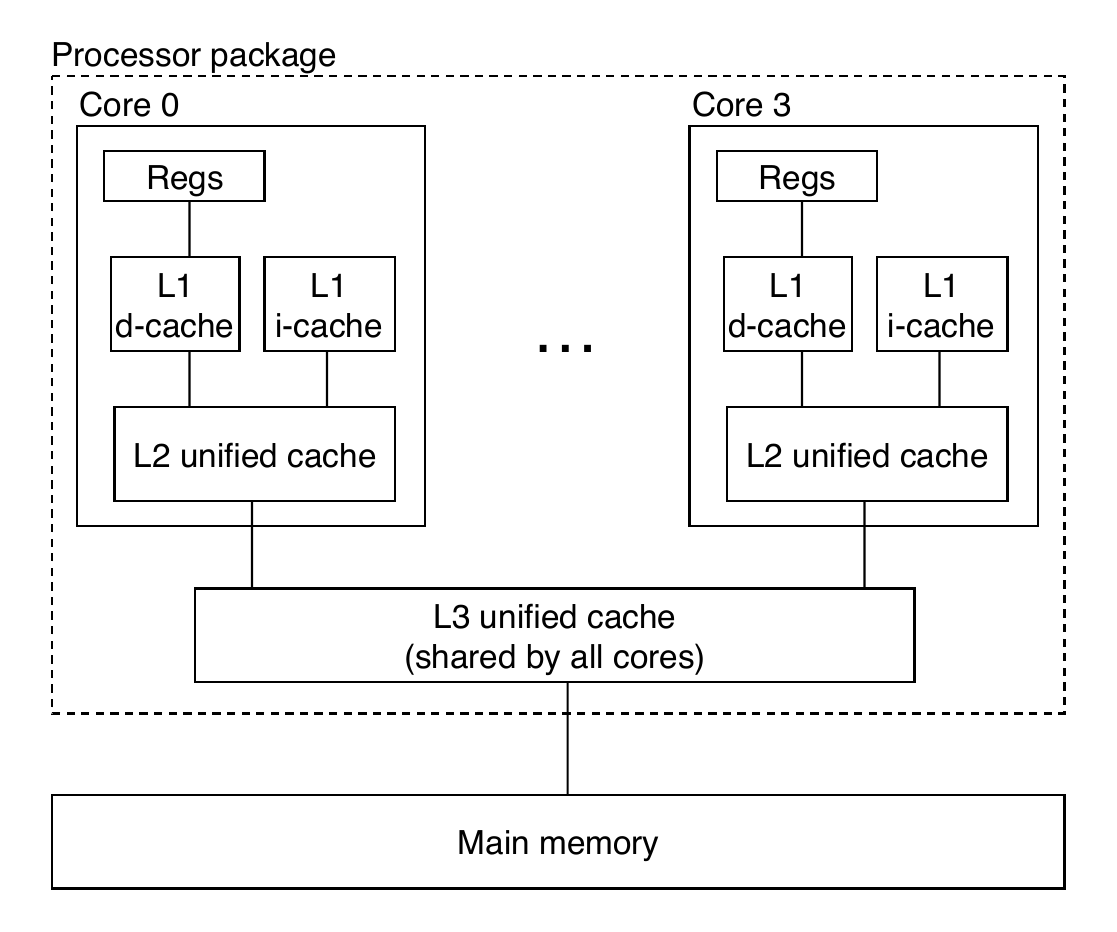
Intel Core i7 Cache Hierarchy
- L1 i-cache and d-cache:
- 32 KB, 8-way
- Access: 4 cycles
- L2 unified cache:
- 256 KB, 8-way
- Access: 10 cycles
- L3 unified cache:
- 8 MB, 16-way
- Access: 40 - 75 cycles
- Block size: 64 bytes for all caches
Cache Performance Metrics
- Miss Rate
- Fraction of memory accesses not found in cache (misses / access)
- Typical numbers:
- 3-10% for L1
- can be quite small for L2, depending on size, etc.
- Hit Time
- Time to deliver a cached block to the processor
- includes time to determine whether line is in cache
- Typical numbers:
- 4 clock cycles for L1
- 10 clock cycles for L2
- Time to deliver a cached block to the processor
- Miss Penalty
- Additional time required because of a miss
- typically 50-200 cycles for main memory (trend: increasing)
- Additional time required because of a miss
How Bad Can a Few Cache Misses Be?
- Huge difference between a hit and a miss
- Could be 100x if just L1 and main memory
- Would you believe 99% hits is twice as good as 97%?
- Consider this simplified example:
- cache hit time of 1 cycle
- cache miss penalty of 100 cycles
- Average access time:
- 97% hits: 1 cycle + 0.03 \(\times\) 100 cycles = 4 cycles
- 99% hits: 1 cycle + 0.01 \(\times\) 100 cycles = 2 cycles
- Consider this simplified example:
- This is why “miss rate” is used instead of “hit rate”
Writing Cache Friendly Code
- Make the common case go fast
- Focus on the inner loops of the core functions
- Minimize the misses in the inner loops
- Repeated references to variables are good (temporal locality)
- Stride-1 reference patterns are good (spatial locality)
- Key idea: our qualitative notion of locality is quantified through our understanding of cache memories
The Memory Mountain
- Read throughput (read bandwidth)
- Number of bytes read from memory per second (MB/s)
- Memory mountain: measured read throughput as a function of spatial and temporal locality
- Compact way to characterize memory system performance
Memory Mountain Test Function
long data[MAXELEMS]; /* Global array to traverse */
/* test - Iterate over first "elems" elements of
* array "data" with stride of "stride“,
* using 4x4 loop unrolling.
*/
int test(int elems, int stride) {
long i, sx2=stride*2, sx3=stride*3, sx4=stride*4;
long acc0 = 0, acc1 = 0, acc2 = 0, acc3 = 0;
long length = elems, limit = length - sx4;
/* Combine 4 elements at a time */
for (i = 0; i < limit; i += sx4) {
acc0 = acc0 + data[i];
acc1 = acc1 + data[i+stride];
acc2 = acc2 + data[i+sx2];
acc3 = acc3 + data[i+sx3];
}
/* Finish any remaining elements */
for (; i < length; i++) {
acc0 = acc0 + data[i];
}
return ((acc0 + acc1) + (acc2 + acc3));
}The Memory Mountain
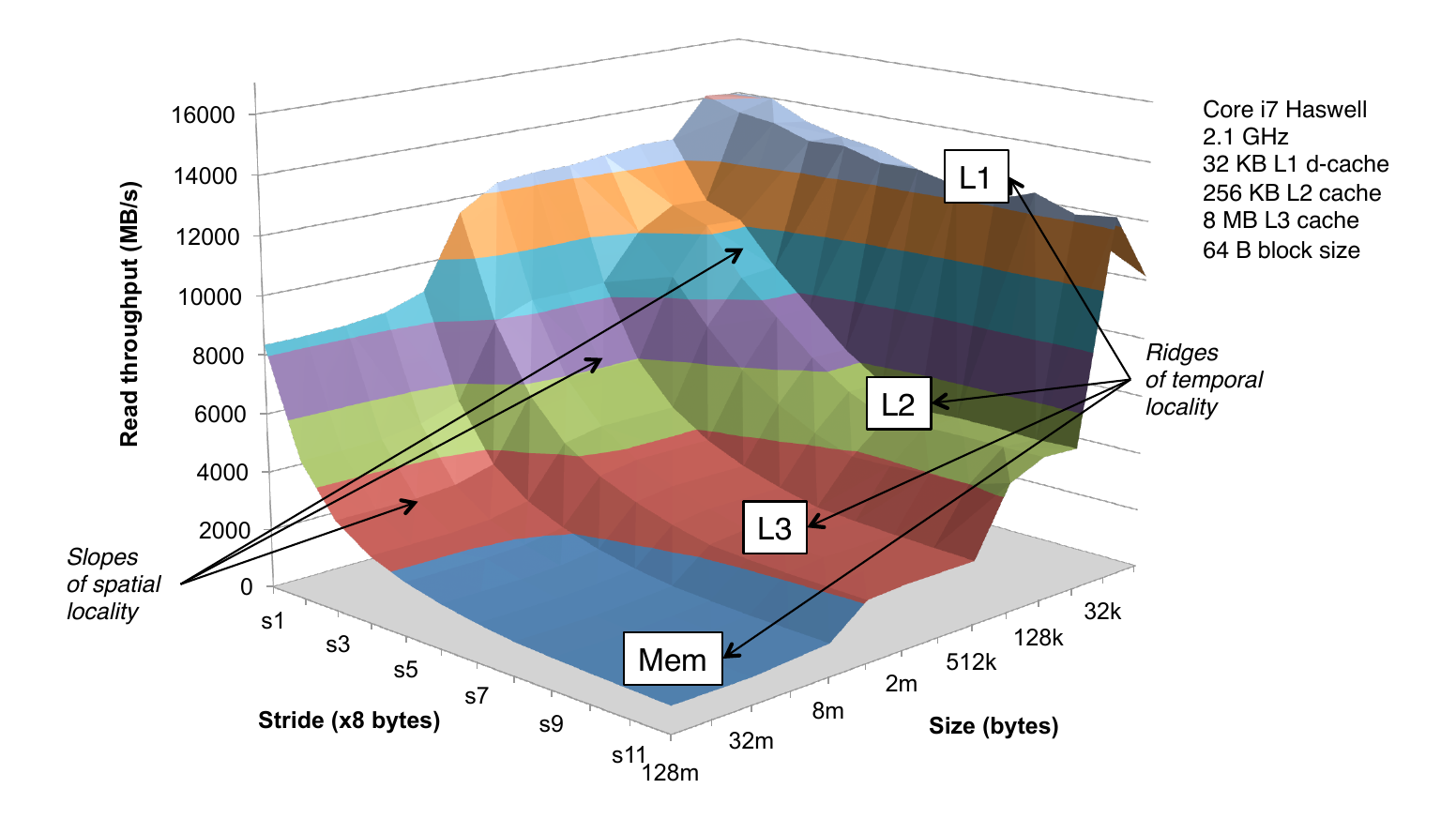
Matrix Multiplication Example
- Description:
- Multiply \(N \times N\) matrices
- Matrix elements are doubles (8 bytes)
- \(\mathcal{O}(n^3)\) total operations
- \(N\) reads per source element
- \(N\) values summed per destination
- but may be able to hold in register
Matrix Multiplication Example
- \(C = A \times B\)
for (i=0; i<n; i++) {
for (j=0; j<n; j++) {
sum = 0.0;
for (k=0; k<n; k++)
sum += a[i][k] * b[k][j];
c[i][j] = sum;
}
}Miss Rate Analysis for Matrix Multiply
- Assume:
- Block size = 32 B (big enough for doubles)
- Matrix dimension \(N\) is very large
- Approximate \(1/N\) as 0.0
- Cache is not even big enough to hold multiple rows
- Analysis Method:
- Look at access pattern of inner loop
Layout of C Arrays in Memory (review)
- C arrays allocated in row-major order
- each row in contiguous memory
Stepping through columns in one row:
- Code
for (i = 0; i < N; i++) sum += a[0][i]- accesses successive elements
- if block size \(B > sizeof(a_{ij})\) bytes, then exploit spatial locality
- miss rate = \(sizeof(a_{ij}) / B\)
Stepping through rows in one column:
- Code
for (i = 0; i < N; i++) sum += a[i][0]- accesses distant elements
- no spatial locality
- miss rate = 1 (that is, 100%)
Matrix Multiplication (ijk)
for (i=0; i<n; i++) {
for (j=0; j<n; j++) {
sum = 0.0;
for (k=0; k<n; k++)
sum += a[i][k] * b[k][j];
c[i][j] = sum;
}
}- Miss rate for inner loop iterations
- A = 0.25 (row-wise)
- B = 1.0 (column-wise)
- C = 0.0 (fixed)
Matrix Multiplication (kij)
for (k=0; k<n; k++) {
for (i=0; i<n; i++) {
r = a[i][k];
for (j=0; j<n; j++)
c[i][j] += r * b[k][j];
}
}- Miss rate for inner loop iterations
- A = 0.0 (fixed)
- B = 0.25 (row-wise)
- C = 0.25 (row-wise)
Matrix Multiplication (jki)
for (j=0; j<n; j++) {
for (k=0; k<n; k++) {
r = b[k][j];
for (i=0; i<n; i++)
c[i][j] += a[i][k] * r;
}
}- Miss rate for inner loop iterations
- A = 1.0 (column-wise)
- B = 0.0 (fixed)
- C = 1.0 (column-wise)
Summary of Matrix Multiplication
- ijk (and jik)
- 2 loads, 0 stores
- average misses per iteration = 1.25
- kij (and ikj)
- 2 loads, 1 store
- average misses per iteration = 0.5
- jki (and kji)
- 2 loads, 1 store
- average misses per iteration = 2.0
Core i7 Matrix Multiply Performance

Matrix Multiplication (Again)
c = (double *) calloc(sizeof(double), n*n);
/* Multiply n x n matrices a and b */
void mmm(double *a, double *b, double *c, int n) {
int i, j, k;
for (i = 0; i < n; i++)
for (j = 0; j < n; j++)
for (k = 0; k < n; k++)
c[i*n + j] += a[i*n + k] * b[k*n + j];
}Cache Miss Analysis
- Assume:
- Matrix elements are doubles
- Cache line = 8 doubles
- Cache size is strictly smaller than \(N\)
- First iteration:
- \(N/8 + N = 9N/8\) misses
- Second iteration:
- \(N/8 + N = 9N/8\) misses
- Total misses:
- \(9N/8 N^2 = (9/8) N^3\)
Blocked Matrix Multiplication
c = (double *) calloc(sizeof(double), n*n);
/* Multiply n x n matrices a and b */
void mmm(double *a, double *b, double *c, int n) {
int i, j, k;
for (i = 0; i < n; i+=L)
for (j = 0; j < n; j+=L)
for (k = 0; k < n; k+=L)
/* L x L mini matrix multiplications */
for (i1 = i; i1 < i+L; i1++)
for (j1 = j; j1 < j+L; j1++)
for (k1 = k; k1 < k+L; k1++)
c[i1*n+j1] += a[i1*n + k1]*b[k1*n + j1];
}Cache Miss Analysis
- Assume:
- Cache line = 8 doubles, Blocking size \(L \geq 8\)
- Cache size is strictly smaller than \(N\)
- Three blocks fit into cache: \(3L^2 < C\)
- First (block) iteration:
- Misses per block: \(L^2/8\)
- Blocks per iteration: \(2N/L\) (omitting matrix c)
- Misses per iteration: \(2N/L \times L^2/8 = NL/4\)
- Afterwards in cache
- Second (block) iteration:
- Same misses as first iteration: \(NL/4\)
- Total misses:
- \(NL/4\) misses per iteration \(\times\) \((N/L)^2\) iterations = \(N^3/(4L)\) misses
Blocking Summary
- No blocking: \((9/8) N^3\) misses
Blocking: \((1/(4L)) N^3\) misses
- Use largest block size \(L\), such that \(L\) satisfies \(3L^2 < C\)
- Fit three blocks in cache: two input, one output
- Reason for dramatic difference
- Matrix multiplication has inherent temporal locality:
- Input data: \(3N^2\), computation \(2N^3\)
- Every array element used \(\mathcal{O}(n)\) times
- But, the program needs to be written properly
- Matrix multiplication has inherent temporal locality:
Cache Summary
Cache memories can have significant performance impact
- You can write your programs to exploit this
- Focus on the inner loops, where the bulk of computations and memory accesses occur
- Try to maximize spatial locality by reading data objects sequentially with stride 1
- Try to maximize temporal locality by using a data object as often as possible once it is read from memory